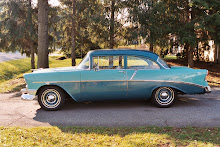Tuesday, July 27, 2010
“ . . . The current 55 mph limit results in prevailing speeds of about 65 mph near the Hayward Road intersection.” Frederick News-Post, June 23, 2010.
“ . . . the majority of posted speed limits in speed zones nationwide are much lower than the 85th percentile speed and in many cases lower than the average speed. . . Traffic engineers maintain . . . the limit should be set at a level at or under which 85 percent of people are driving (85th percentile).” National Motorists Association, Speed Limits, A Recommended Speed Zoning Practice.
“ . . . Some states (such as Pennsylvania) have official tolerances.” Wikipedia, Speed Limit Enforcement.
“ . . . It isn't rigidly enforced: they allow +10% +2mph in most cases.” www.safespeed.org.
According to Chaucer and damn near everyone since, “idle hands (are exploited) by the Devil.” Apparently the same goes for idle minds (never mind other body parts)!
The first four citations are just a glimpse of what I found when I got to looking into the fuss being made locally regarding the intersection of U.S.15 and Hayward Road. The last relates to what happens to me when the air is too dirty to go out and play and the heat index is over 100. In any case, the notion of “+10%+2 mph” and “85th percentile” conjures up all sorts of mischief in my obviously under-utilized mind.
You only have to drive up and down Route 15 to verify that most cars (and big trucks) are living up to expectations; driving at the posted 55 mph will get you passed like you’re standing still (if not rear-ended, run off the road or single-fingered saluted). Of course, only an old fart with nowhere to go and in no hurry to get there would even think about going the speed limit. Them and those of us driving classic cars which feel like they’re speeding at 55 mph.
The quote from the Fredrick News-Post states that a posted speed limit will cause traffic to exceed the posted speed by “about” 18%. The NMA, on the other hand, says that most speed limits are set at less than people are going to drive, that it is expected that the limit will be exceeded by 15%. This information also means that the widely accepted “tolerance” of +10%+2mph is not doing us any favors at a speed limit of 55 mph (+10%+2 mph= 62.5 mph). They are expecting us to drive 63.5 (+15%) to 65 (+18%) and allowing us to drive 62.5. We seem to be playing with house money. Except, of course, in the case of Route 15 where nobody seems to be doing much enforcing anyway.
What if we were to apply these built-in margins for excess to other areas of our lives. We could, for instance, understate our income (or overstate our refunds) by 15-18% or 10%+$2 on our tax returns with impunity. That would certainly result in a tidy windfall for taxpayers but probably significantly skew government revenue projections. That’s assuming they haven’t already built in equivalent fudge-factors and make out like bandits if we behave ourselves.
It is a good thing that the wiggle room built into speed limits is not carried-over to other things we measure (I hope). I don’t want to get only 85% of the gas I buy when I fill-up, or pay +10%+$.02 for the gallons I actually get. That would raise the price of a $2.95 gallon to $3.27 or seriously distort my mpg calculations. Now that I think of it, that’s probably exactly how gas mileage estimates are determined!
How do you think newly re-built engines would work if machinists applied these tolerances to our bores and strokes, bearings, etc. Or if a ±10%±2 standard were applied when the points you were awarded by the car show judges were tallied. OK, I guess if you got the + and the other guy got the -. Maybe that’s the answer; if the fudge factor favors you it’s not so bad, if it favors the other guy it ain’t so good.
I certainly don’t want to find out that the fudge factor is built into my blood pressure reading or my temperature (that would make normal anywhere between 87 and 110, either one of which probably means I’m dead). Overall I think I like precision measurements of all things affecting my health. I don’t think I take much comfort in a prognosis that the Doctor is only 85% sure I’ll be around for my next physical.
I really don’t mind that my old car is only 85% done because, at that point I can say I’ve finished. And I accept that, when calculating the cost of fixing-up the car easily cost +10%+$2K more than I willing to admit to spending. Tolerance is really subjective when it comes to the things we measure. I guess the best lesson to take from all of this is that we should always assume that anything anyone tells us, expects of us, or gives us is likely to have some kind of 85%/+10%+2 fudge factor built in and that we’d best assume the bias is against us.
We live in the Information Age, that is the commodity in which we deal. It is starting to look like information is going to have to have a label just like the stuff we get off the shelf in the grocery store. We need to know what percent of what we’re getting is fact and what percent is fudge factor. The information in this piece, for example; is certified (by me) to contain no more than 51% balderdash (with a ±10%±2 margin for wild imagination).
Tuesday, July 27, 2010
Subscribe to:
Posts (Atom)
